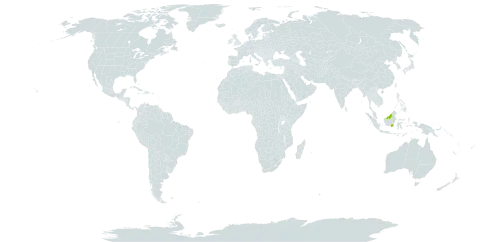Medium-sized tree. Twig, bud, stipule outside, nerves and midrib beneath densely scabrid ocherous to cream pubescent; midrib above evenly so; nerves above and stipule within sparsely evenly so; leaf undersurface densely cream lepidote. Twig c. 2 mm ø apically, much branched, terete to subcompressed, smooth or rugulose; stipule scars short, horizontal. Bud to 8 by 6 mm, ovoid, obtuse, compressed. Stipule to 10 by 6 mm, narrowly ovate, acute, caducous. Leaves 7-10 by 4-9 cm, elliptic to oblong, thickly coriaceous; base broadly cuneate to subcordate; apex obtuse or shortly broadly acuminate; nerves 11-16 pairs, prominent beneath, at 75° at base, 45°-55° towards the apex; tertiary nerves slender, densely scalariform, at c. 90° to the midrib; midrib shallowly depressed above, prominent beneath; petiole 1.5-3.3 cm long, terete, rugose distally. Panicle to 12 cm long, terminal or axillary, +-compressed at first, becoming terete, densely persistently ocherous scabrid pubescent; singly or doubly branched, branchlets to 2 cm long, bearing to 3 ± distichous flowers; bracteoles to 2 by 1 mm, small, elliptic, obtuse, pubescent, caducous. Flower bud to 4 by 3 mm, narrowly ovoid. Sepals pubescent on parts exposed in bud, ovate, acute, the inner 2 relatively shorter, narrower than the outer 3. Petals pale yellow, pubescent on parts exposed in bud, narrowly oblong. Stamens 19-20; filaments compressed, slender, somewhat tapering; anthers oblong, almost as long as filaments, crowned by a short relatively stout glabrous appendage somewhat shorter than the anthers. Ovary ovoid, glabrous; style filiform, c. 2 times as long as ovary, trifid at apex, glabrous. Fruit pedicel to 3 mm long, swelling into the base of the fruit. Calyx sparsely shortly pubescent; 3 longer lobes to 8 by 1.5 cm, narrowly spatulate to sublorate, obtuse, c. 4 mm broad above the to 10 by 6 mm elliptic saccate +-thickened base. Nut to 15 by 12 mm, ovoid, acute, densely evenly buff pubescent.
Can be grown by seedlings. Seeds needs soaking.

